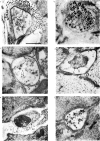Abstract
1. The effects of 6-hydroxydopamine (6-OHDA) on adrenergic nerves in the domestic fowl have been investigated with ultrastructural and fluorescence histochemical methods.
2. 6-OHDA depletes the nerves of catecholamine, initially by displacing it from the storage vesicles. 6-OHDA enters large as well as small vesicles, indicating that large granular vesicles in adrenergic nerves are sites of amine storage.
3. Doses of 6-OHDA, insufficient to cause degeneration, still cause loading of the vesicles.
4. The effects of various drugs on the action of 6-OHDA indicate that this drug must be taken up by the nerves and reach a critical extragranular axoplasmic concentration before degeneration will occur; 6-OHDA bound in the vesicles plays no part in the degenerative process.
Full text
PDF








Images in this article
Selected References
These references are in PubMed. This may not be the complete list of references from this article.
- Buckley G. A., Wheater L. E. The isolated expansor secundariorum--a smooth muscle preparation from the wing of the domestic fowl. J Pharm Pharmacol. 1968 Dec;20(Suppl):114S+–114S+. doi: 10.1111/j.2042-7158.1968.tb09871.x. [DOI] [PubMed] [Google Scholar]
- Hamberger B., Malmfors T. Uptake and release of alpha-methyl-noradrenaline in vitro after reserpine pretreatment. A histochemical study. Acta Physiol Scand. 1967 Jul-Aug;70(3):412–418. doi: 10.1111/j.1748-1716.1967.tb03639.x. [DOI] [PubMed] [Google Scholar]
- LAVERTY R., SHARMAN D. F., VOGT M. ACTION OF 2, 4, 5-TRIHYDROXYPHENYLETHYLAMINE ON THE STORAGE AND RELEASE OF NORADRENALINE. Br J Pharmacol Chemother. 1965 Apr;24:549–560. doi: 10.1111/j.1476-5381.1965.tb01745.x. [DOI] [PMC free article] [PubMed] [Google Scholar]
- Malmfors T., Sachs C. Degeneration of adrenergic nerves produced by 6-hydroxydopamine. Eur J Pharmacol. 1968 Apr;3(1):89–92. doi: 10.1016/0014-2999(68)90056-3. [DOI] [PubMed] [Google Scholar]
- PORTER C. C., TOTARO J. A., STONE C. A. Effect of 6-hydroxydopamine and some other compounds on the concentration of norepinephrine in the hearts of mice. J Pharmacol Exp Ther. 1963 Jun;140:308–316. [PubMed] [Google Scholar]
- Porter C. C., Totaro J. A., Burcin A. The relationship between radioactivity and norepinephrine concentrations in the brains and hearts of mice following administration of labeled methyldopa or 6-hydroxydopamine. J Pharmacol Exp Ther. 1965 Oct;150(1):17–22. [PubMed] [Google Scholar]
- SHORE P. A., BUSFIELD D., ALPERS H. S. BINDING AND RELEASE OF METARAMINOL: MECHANISM OF NOREPINEPHRINE DEPLETION BY ALPHA-METHYL-M-TYROSINE AND RELATED AGENTS. J Pharmacol Exp Ther. 1964 Nov;146:194–199. [PubMed] [Google Scholar]
- Thoenen H., Tranzer J. P. Chemical sympathectomy by selective destruction of adrenergic nerve endings with 6-Hydroxydopamine. Naunyn Schmiedebergs Arch Exp Pathol Pharmakol. 1968;261(3):271–288. doi: 10.1007/BF00536990. [DOI] [PubMed] [Google Scholar]
- Tranzer J. P., Thoenen H. An electron microscopic study of selective, acute degeneration of sympathetic nerve terminals after administration of 6-hydroxydopamine. Experientia. 1968 Feb 15;24(2):155–156. doi: 10.1007/BF02146956. [DOI] [PubMed] [Google Scholar]
- Tranzer J. P., Thoenen H. Various types of amine-storing vesicles in peripheral adrenergic nerve terminals. Experientia. 1968 May 15;24(5):484–486. doi: 10.1007/BF02144407. [DOI] [PubMed] [Google Scholar]



